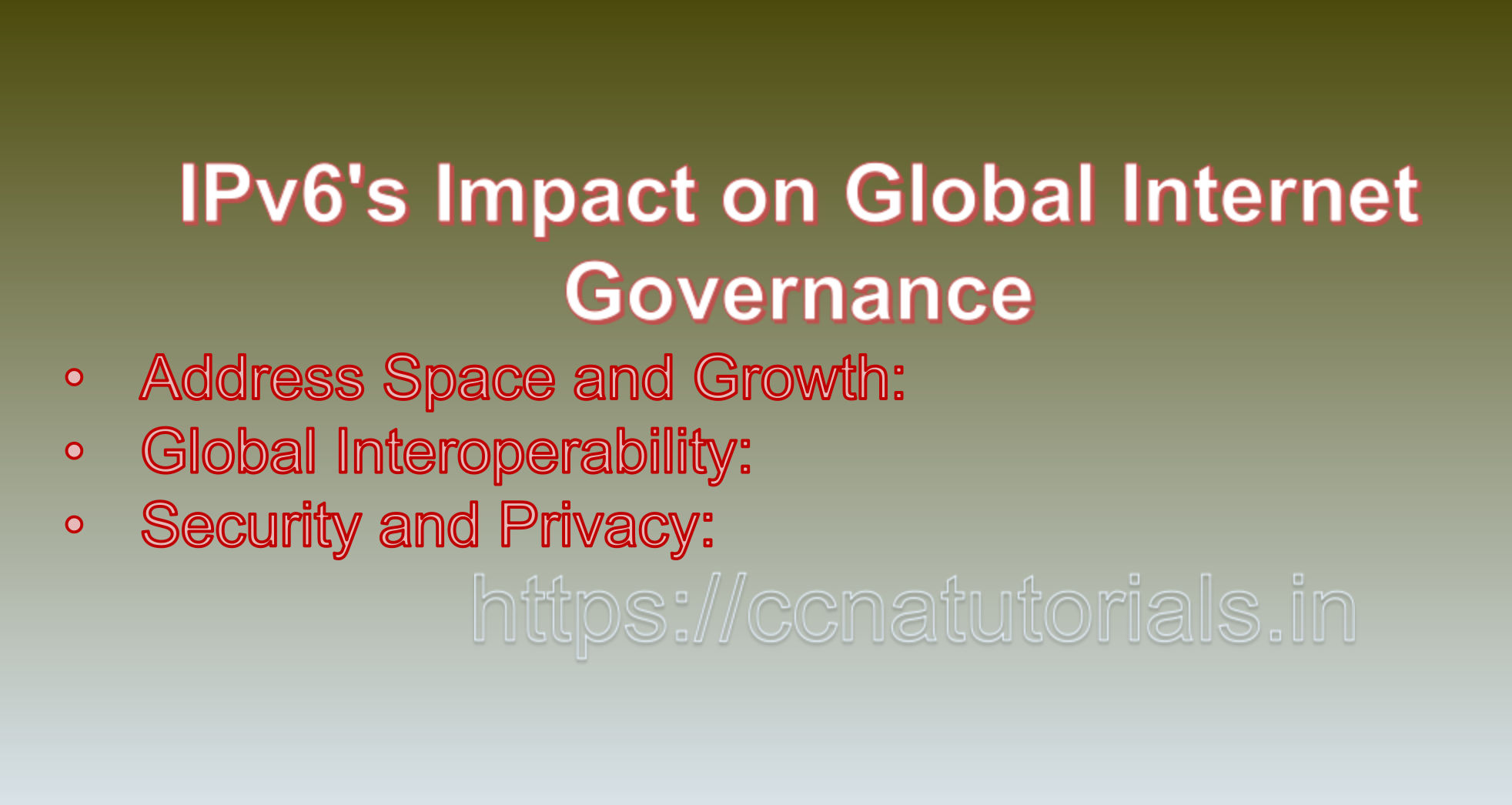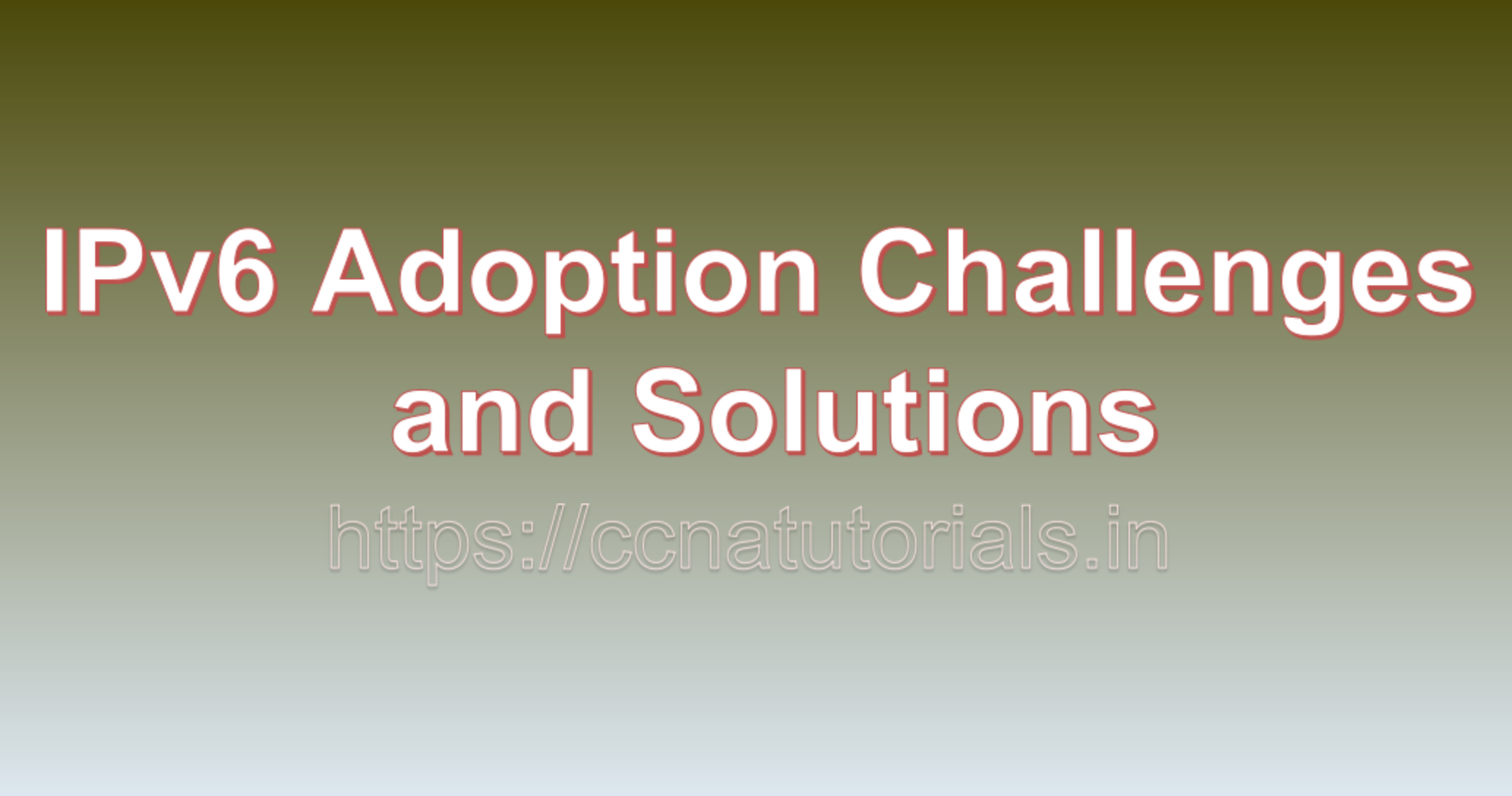Contents of this article
In this article, I describe IPv6 and Global Internet Governance: Shaping the Future of Connectivity. Global Internet governance involves the coordination and management of the internet’s technical and policy-related aspects on a global scale. As the internet continues to evolve and expand, the transition from Internet Protocol version 4 (IPv4) to Internet Protocol version 6 (IPv6) plays a crucial role in shaping the future of global internet governance. IPv6’s expanded address space and enhanced features address the limitations of IPv4 and impact various aspects of internet governance. This article explores the intersection of IPv6 and global internet governance, highlighting its implications and significance.
1. IPv6’s Impact on Global Internet Governance:
– Address Space and Growth:
IPv6’s vast address space is essential to accommodate the growing number of internet-connected devices, enabling the expansion of the internet’s reach and potential.
– Global Interoperability:
IPv6’s adoption promotes uniformity and interoperability in addressing, facilitating seamless communication and data exchange across diverse networks and regions.
– Security and Privacy:
IPv6’s built-in security features, including mandatory support for Internet Protocol Security (IPsec), contribute to the enhancement of data security and privacy across the global internet.
2. IPv6 and Key Aspects of Global Internet Governance:
– Internet Assigned Numbers Authority (IANA):
IANA plays a critical role in allocating and managing IP address blocks. IPv6 adoption affects IP address allocation policies and ensures efficient distribution of IPv6 addresses to different regions.
– Regional Internet Registries (RIRs):
RIRs manage the distribution of IP address resources within specific geographical regions. IPv6 adoption involves RIRs’ efforts to educate and facilitate the adoption of IPv6 across their respective regions.
– Domain Name System (DNS):
DNS is a fundamental component of the internet, translating domain names into IP addresses. IPv6 adoption necessitates updates to DNS infrastructure to support IPv6 records and facilitate seamless name resolution.
3. IPv6’s Role in Global Internet Governance:
– Internet Governance Forums (IGFs):
IPv6’s adoption is a significant topic of discussion at international IGFs, where stakeholders from various sectors address policy, technical, and social implications of IPv6 transition.
– Internet Society (ISOC):
ISOC promotes the adoption of IPv6 through advocacy, awareness campaigns, and collaboration with stakeholders, ensuring the successful transition to IPv6.
– Regional Collaborations:
Regional organizations and groups work together to foster IPv6 adoption within specific geographical areas, highlighting the collaborative nature of global internet governance.
4. IPv6 and Internet Governance Case Studies:
– IPv6 Adoption in Developing Countries:
– Scenario: A developing country seeks to bridge the digital divide and enhance internet connectivity for its citizens. The government collaborates with international organizations to accelerate IPv6 adoption and enable internet access for remote areas.
Outcome:
– The government allocates IPv6 address blocks to internet service providers (ISPs) to support the growing number of internet users.
– Collaborative efforts result in awareness campaigns, workshops, and training programs to educate network administrators and policymakers about IPv6’s benefits and implementation.
– Regional IPv6 Adoption Initiative:
– Scenario: A group of countries within a specific region recognizes the need to harmonize IPv6 adoption efforts to ensure efficient communication and data exchange across borders.
Outcome:
– Countries within the region collaborate to develop a regional IPv6 adoption plan, addressing policy, technical, and capacity-building aspects.
– By sharing best practices, experiences, and resources, countries collectively enhance their technical capabilities and facilitate a smoother transition to IPv6.
5. IPv6 Implementation and Policy Steps for Global Internet Governance:
– Coordination:
Governments, international organizations, technical communities, and civil society must collaborate to establish coherent policies and strategies for IPv6 adoption.
– Capacity Building:
Provide training and capacity-building programs to network administrators, policymakers, and other stakeholders to enhance their understanding of IPv6 and its implications.
– Policy Development:
Develop clear and flexible policies that encourage IPv6 adoption while addressing the specific needs and challenges of different regions.
– Collaboration:
Foster partnerships among governments, industry players, and civil society to ensure a coordinated and collaborative approach to IPv6 implementation.
6. Benefits of IPv6 in Global Internet Governance:
– Enhanced Connectivity:
IPv6 adoption enables the expansion of internet access, bridging the digital divide and ensuring global connectivity.
– Efficient Resource Allocation:
IPv6’s larger address space allows for efficient and equitable allocation of IP addresses, supporting the diverse needs of different regions.
– Interoperability:
IPv6’s uniform addressing structure promotes interoperability and consistent communication across diverse networks, regions, and devices.

In short IPv6 and Global Internet Governance: Paving the Way for a Connected Future:
The transition to IPv6 is an essential step in the evolution of the internet, and its impact extends to the realm of global internet governance. As governments, organizations, and stakeholders collaborate to facilitate IPv6 adoption, they shape the future of connectivity and communication on a global scale. By embracing the opportunities IPv6 offers and addressing its challenges, the global community works together to ensure that the internet remains an open, secure, and interconnected platform for innovation, collaboration, and progress.
IPv6 and Global Internet Governance: Paving the Way for a Connected Future
The global internet has become an integral part of modern society, transforming communication, commerce, and virtually every aspect of daily life. As the number of connected devices continues to rise, the limitations of the current addressing system, Internet Protocol version 4 (IPv4), have become evident. Internet Protocol version 6 (IPv6) offers a solution to address this challenge and ensure the internet’s growth and sustainability. However, the widespread adoption of IPv6 also raises questions about its integration into the framework of global internet governance. This article explores how IPv6 intersects with global internet governance, its implications, and the collaborative efforts required to ensure a smooth transition.
1. IPv6’s Role in Global Internet Governance:
– Address Space Exhaustion:
IPv4’s limited address space has led to the depletion of available addresses, hindering the internet’s capacity to accommodate new devices and services.
– Scalability and Growth:
IPv6’s vast address space provides the scalability needed for the growing number of internet-connected devices, ensuring that the internet remains an open and accessible platform for innovation.
– Security Enhancements:
IPv6’s built-in security features, such as Internet Protocol Security (IPsec), contribute to a safer online environment, addressing concerns related to data privacy and cybersecurity.
2. Global Internet Governance and IPv6:
– Technical Coordination:
Global internet governance encompasses technical aspects, such as the management of domain names, IP address allocation, and protocol standards. IPv6’s adoption requires coordination among various stakeholders to ensure interoperability and smooth functioning.
– Policy Development:
IPv6’s integration into global internet governance involves the formulation of policies and regulations that address the unique challenges and opportunities presented by the transition.
– Capacity Building:
Global internet governance initiatives aim to educate and empower stakeholders about IPv6’s benefits, technical aspects, and implications, promoting its widespread adoption.
3. Collaborative Efforts for IPv6 Integration:
– Regional Internet Registries (RIRs):
RIRs play a vital role in the distribution of IP addresses. They collaborate with internet service providers (ISPs) and organizations to facilitate IPv6 adoption by providing resources and guidance.
– Internet Governance Forums:
Forums such as the Internet Governance Forum (IGF) foster discussions on IPv6 adoption, bringing together policymakers, technologists, businesses, and civil society to address challenges and share best practices.
– International Telecommunication Union (ITU):
ITU’s initiatives promote IPv6 deployment by facilitating cooperation among countries, sharing knowledge, and offering capacity-building programs.
4. IPv6 Integration in Global Internet Governance:
– Address Allocation Policies:
– Scenario: Regional internet registries collaborate with ISPs to develop address allocation policies that encourage IPv6 adoption.
Outcome:
– ISPs receive IPv6 address blocks to distribute to their customers, ensuring a smooth transition and equitable allocation of address space.
– IPv6 adoption accelerates as organizations have the necessary resources to deploy IPv6 networks and services.
– Public Awareness Campaigns:
– Scenario: International organizations collaborate to run public awareness campaigns to educate individuals and businesses about the importance of IPv6 adoption.
Outcome:
– Increased awareness prompts individuals to demand IPv6-compatible devices and services from providers, encouraging wider adoption.
– Businesses recognize the strategic advantage of embracing IPv6, driving its integration into their operations.
5. IPv6 and Global Internet Governance Challenges:
– Coordination and Cooperation:
IPv6’s successful integration requires coordination among multiple stakeholders, including governments, industry bodies, ISPs, and content providers.
– Legacy Infrastructure:
The coexistence of IPv4 and IPv6 introduces compatibility challenges, necessitating the development of transition mechanisms and strategies.
– Policy Harmonization:
Diverse policies and regulations across countries can impede seamless IPv6 adoption, requiring harmonization efforts to ensure consistent governance.
6. IPv6 Integration in Global Internet Governance: Examples in Practice:
– RIR Collaboration:
– Scenario: Regional internet registries collaborate to develop a unified IPv6 adoption strategy that aligns with global internet governance principles.
Outcome:
– The strategy ensures consistent allocation policies and addresses concerns related to address exhaustion and technical interoperability.
– ISPs and organizations worldwide have a clear roadmap for IPv6 deployment, promoting widespread adoption.
– Multi-Stakeholder Collaboration:
– Scenario: Governments, private sector entities, and civil society organizations collaborate to host an international conference on IPv6 adoption and governance.
Outcome:
– Participants discuss challenges, share success stories, and propose strategies for overcoming barriers to IPv6 integration.
– Governments align their policies with technical advancements, ensuring that regulations facilitate rather than hinder IPv6 adoption.
Conclusion for IPv6 and Global Internet Governance Embracing IPv6 within Global Internet Governance:
IPv6’s transition is not solely a technical endeavor; it’s a global collaborative effort that requires coordination, awareness, and policy alignment. Global internet governance forums, organizations, and stakeholders must work together to integrate IPv6 seamlessly into the fabric of the internet. By addressing challenges related to compatibility, coordination, and policy harmonization, the internet community can ensure a future where IPv6 empowers the internet’s growth, security, and accessibility. The adoption of IPv6 within the framework of global internet governance paves the way for a connected future that meets the demands of an increasingly digital world.






